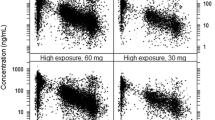Summary
The pharmacokinetics of flucloxacillin in plasma and tissue fluid after i.v. infusion of 1 g was analyzed according to an open two-compartment model in 19 patients with bradyarrhythmias (mean age 70.8 years) admitted for implantation or replacement of a permanent pacemaker system. After the first infusion of flucloxacillin (5 min), the distribution phase was rapid (t1/2α=0.13 h). The plasma half-life of elimination (t1/2β) was 1.51 h, which is almost twice as long as reported in healthy volunteers. Total plasma clearance (93.1 ml/min) was also lower than is usually found in healthy individuals, due to low renal clearance of flucloxacillin (60.2 ml/min). The total apparent volume of distribution during the β-phase (Vdarea) was 0.172 l/kg and distribution in the central compartment (Vc) 0.064 l/kg. In each patient plasma protein binding and drug distribution to plasma water, proteins and blood cells in whole blood were determined. Binding in plasma to proteins was 91.0% and distribution to blood cells in whole blood 13.8%. The mean distribution volume of free flucloxacillin during the β-phase (Vdβ free) was 2.18 l/kg, which exceeds total body water, suggesting possible intracellular distribution and substantial tissue binding. Plasma concentrations of flucloxacillin after the fourth dose (1 g t.i.d.) were very similar to those obtained after the first infusion and those predicted from the single dose kinetics. The concentration of flucloxacillin in fluid from the pacemaker pockets in 5 patients averaged 12.1 µg/ml and 9.5 µg/ml at 1 and 5 h, respectively, which was more than ten times the MIC-values for Staphylococcus aureus and S. epidermidis. The average concentration ratio (tissue fluid/plasma) was 0.57. Thus the pharmacokinetics of flucloxacillin in these elderly patients exhibited marked differences from what has been found in healthy volunteers. Despite the high degree of plasma protein binding, flucloxacillin appears to distribute rapidly and efficiently to extravascular compartments, such as a pacemaker pocket.
Similar content being viewed by others
References
Barza M, Weinstein L (1976) Pharmacokinetics of the penicillins in man. Clin Pharmacokinet 1: 297–308
Barza M (1981) Principles of tissue penetration of antibiotics. J Antimicrob Chemother 8 [Suppl] C: 7–28
Bergan T, Øydvin B (1974) Cross-over study of penicillin pharmacokinetics after intravenous infusions. Chemotherapy 20: 263–279
Craig WA, Welling PG (1977) Protein binding of antimicrobals: clinical pharmacokinetic and therapeutic implications. Clin Pharmacokinet 2: 252–268
Diem K (ed); (1962) Documenta Geigy: Scientific tables, sixth edn. J. R. Geigy S. A., Basle, Switzerland
Ehrnebo M (1974) Pharmacokinetics and distribution properties of pentobarbital in humans following oral and intravenous administration. J Pharm Sci 63: 1114–1118
Ehrnebo M, Agurell S, Boréus LO, Gordon E, Lönroth U (1974) Pentazocine binding to blood cells and plasma proteins. Clin Pharmacol Ther 16: 424–429
Ehrnebo M, Odar-Cederlöf I (1975) Binding of amobarbital, pentobarbital and diphenylhydantoin to blood cells and plasma proteins in healthy volunteers and uraemic patients. Eur J Clin Pharmacol 8: 445–453
Ehrnebo M (1978) Distribution of ampicillin in whole blood. J Pharm Pharmacol 30: 730–731
Ehrnebo M, Nilsson SO, Boréus LO (1979) Pharmacokinetics of ampicillin and its prodrugs bacampicillin and pivampicillin in man. J Pharmacokinet Biopharm 7: 429–450
Gibaldi M, Perrier D (1975) Pharmacokinetics. In: J Swarbrick (ed) Drugs and the pharmaceutical sciences, vol. 1. Marcel Dekker, New York
Hedström SÅ, Kahlmeter G (1980) Dicloxacillin and flucloxacillin twice daily with probenecid in staphylococcal infections. Scand J Infect Dis 12: 221–225
Herngren L, Ehrnebo M, Boréus, LO (1982) Drug distribution in whole blood of mothers and their newborn infants: studies of cloxacillin and flucloxacillin. Eur J Clin Pharmacol 22: 351–358
Jalling B, Malmborg AS, Lindman A, Boréus LO (1972) Evaluation of a micromethod for determination of antibiotic concentrations in plasma. Eur J Clin Pharmacol 4: 150–157
Kunin CM, Craig WA, Kornguth M, Monson R (1973) Influence of binding on the pharmacologic activity of antibiotics. Ann N Y Acad Sci 226: 214–224
Marcy SM, Klein JO (1970) The isoxazolyl penicillins: oxacillin, cloxacillin and dicloxacillin. Med Clin N Amer 54: 1127–1143
Nauta EH, Mattie H (1975) Pharmacokinetics of flucloxacillin and cloxacillin in healthy subjects and patients on chronic intermittent haemodialysis. Br J Clin Pharmacol 2: 111–121
Rolinson GN (1980) The significance of protein binding of antibiotics in antibacterial chemotherapy. J Antimicrob Chemother 6: 311–317
Siersbaeck-Nielsen K, Mølholm Hansen J, Kampmann J, Kristensen M (1971) Rapid evaluation of creatinine clearance. Lancet 1: 1133–1134
Sutherland R, Croydon EAP, Rolinson GN (1970) Flucloxacillin, a new isoxazolyl penicillin, compared with oxacillin, cloxacillin and dicloxacillin. Br Med J 2: 455–460
Thijssen HHW, Wolters J (1982) The metabolic disposition of flucloxacillin in patients with impaired kidney function. Eur J Clin Pharmacol 22: 429–434
Wagner JG (1975) Fundamentals of clinical pharmacokinetics. First edition. Drug Intelligence Publications, Hamilton, Illinois, USA
Wise R, Gillett AP, Cadge B, Durham SR, Baker S (1980) The influence of protein binding upon tissue fluid levels of six β-lactam antibiotics. J Infect Dis 142: 77–82
Wise R (1983) Protein binding of β-lactams: the effects on activity and pharmacology particulary tissue penetration. II. J Antimicrob Chemother 12: 105–118
Author information
Authors and Affiliations
Rights and permissions
About this article
Cite this article
Anderson, P., Bluhm, G., Ehrnebo, M. et al. Pharmacokinetics and distribution of flucloxacillin in pacemaker patients. Eur J Clin Pharmacol 27, 713–719 (1985). https://doi.org/10.1007/BF00547055
Accepted:
Issue Date:
DOI: https://doi.org/10.1007/BF00547055




